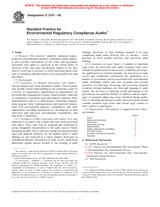Potřebujeme váš souhlas k využití jednotlivých dat, aby se vám mimo jiné mohly ukazovat informace týkající se vašich zájmů. Souhlas udělíte kliknutím na tlačítko „OK“.
ASTM E2107-00
Standard Practice for Environmental Regulatory Compliance Audits
Automaticky přeložený název:
Standardní praxe pro životní prostředí dodržování právních předpisů auditů
NORMA vydána dne 10.10.2000
Informace o normě:
Označení normy: ASTM E2107-00
Poznámka: NEPLATNÁ
Datum vydání normy: 10.10.2000
Kód zboží: NS-44317
Počet stran: 5
Přibližná hmotnost: 15 g (0.03 liber)
Země: Americká technická norma
Kategorie: Technické normy ASTM
Anotace textu normy ASTM E2107-00 :
Keywords:
environmental audit, environmental compliance, environmental management, ICS Number Code 13.020.10 (Environmental management)
Doplňující informace
| 1. Scope | ||||||||||||||||||||
|
1.1 PurposeThis practice identifies minimum requirements for environmental regulatory compliance audits (audits). It also provides information on the terms and procedures associated with audits as practiced in the United States of America (USA) and other jurisdictions subject to the laws thereof. It provides a reference to which interested parties may refer for definition and description of accepted audit terms and procedures. 1.2 Background: 1.2.1 Awareness of Benefits Associated with Audits--Various benefits have been attributed to audits. These benefits may include a better understanding of the compliance status of a facility or organization, identification of opportunities for environmental management systems improvements, reduction or elimination of potential legal and financial liabilities when implemented as part of a comprehensive compliance management program, better communications and improved relationships with governmental agencies, communities, and other stakeholders, providing information for development of both short-term and long-term environmental expenditures, and education of employees. 1.2.2 Awareness of Risks Associated with Audits--It is also important to recognize that certain risks have been associated with audits. These risks may be managed and controlled by giving thoughtful consideration to the audit process before beginning an audit. These risks may include increased potential legal and financial liabilities for the audited entity if audit findings are not corrected in a timely manner, disclosure of confidential business information or trade secrets, inadvertent admissions against interest because of the wording of audit findings, disclosure of audit findings intended to be kept confidential under audit privilege laws or attorney - client privilege or work product doctrine, and inaccurate audit findings. 1.2.3 Awareness of Legal Issues--A number of important legal issues are associated with audits. Example legal issues include the qualification for one or more evidentiary privileges, the qualification for limited immunity, the protection of trade secrets and confidential information, the application of a number of government policies associated with environmental audits (including federal and state programs that provide incentives for detecting, disclosing, and correcting potential violations through auditing), the form and language of audit reports, the necessity of reporting certain information to the government, the potential liability of auditors, and the importance of promptly addressing issues identified during audits. Prior to initiating and during an audit, interested parties should consider potential legal issues and consult legal counsel or other experts as appropriate. 1.3 Organization-- This practice is organized in the following manner:
|
||||||||||||||||||||
| 2. Referenced Documents | ||||||||||||||||||||
|
Doporučujeme:
Aktualizace technických norem
Chcete mít jistotu, že používáte pouze platné technické normy?
Nabízíme Vám řešení, které Vám zajistí měsíční přehled o aktuálnosti norem, které používáte.
Chcete vědět více informací? Podívejte se na tuto stránku.




 Cookies
Cookies
